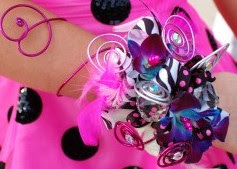Silk versus fresh flowers. It's an ongoing debate. Both sides have their die-hard loyalists. And like most debates, you can probably find equal numbers from both camps. My opinion? Well, it depends...on a lot of factors.
- Are the fresh flowers desired available?
- How long will the flowers need to last?
- Is there a wedding with reception and open house in two different locations that both need flowers?
- Does one have access to wholesale, quality silks (or permanent botanicals as they are sometimes called)?
- How many stems of the desired varieties are needed?
- Can you find the colors needed?
- If it's a DIY attempt for an event such as a wedding, is the person arranging them going to have time to be working with fresh flowers the day before or morning of the event? (I once heard a horror story of the mother of a bride arranging flowers, in tears, at 3 a.m. the morning of her daughter's wedding...so much for looking your best for family pictures!)
I frequently get asked, "What about the cost difference of silk and fresh?" It's been my experience that silk is often more expensive,
if you're using high quality brands of flowers that are usually only available through wholesalers. But it also depends on how many stems are needed. If you only need 3 lilies, and the fresh wholesale lilies only come in bunches of 10, well then, fresh might be more costly. So like I said, there are many factors to consider.
Now here's another issue people are worried about--how will the silk flowers look compared to fresh? You decide after looking at a few pictures below:
So what's your vote? Fresh or silk? They're both silk (trust me, I made them). Now here's a thought for you...how about combining fresh and silk? Sometimes that can be necessary depending on availability.
The photos below are of a combination bouquet I made. The red roses are real and all other flowers and greenery are silk. The decision was made to make it that way due to availability issues, and it was less expensive to use real roses rather than quality silk ones.
Lots of options. I've used special spray paint made for fresh flowers to create the needed color, and I've used craft paint on silks to tweek them into usefulness. In fact, the white anemone flowers in the above picture came with yellow centers and I needed black...so voila...black paint and a small paint brush.
I made an arrangement years ago that used silk red roses and fresh greenery. I happened to see a lady at the event bend over and "smell" the roses. She was unaware of the fact that I had made the arrangement or that I was watching her. I looked on with curiosity as to what she would do. I was quite surprised to hear her say, "Um, they smell so good!" I knew silk flowers could fool the eye, but I underestimated their ability to fool the nose as well!
So silk versus fresh? You decide!


































